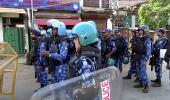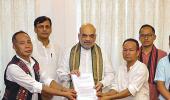The present happenings in Manipur are the wages of continued neglect, and not so benign at that, of a vital region and its people.
Had we lavished on the North East even a fraction of the care and resources we do on Kashmir, things would not have come to this pass, asserts Shreekant Sambrani.

It is commonplace in the North East to hear people from Assam and further west being called Indians, but not because the local populace does not consider itself Indian (except perhaps the more radical Nagas).
It is simply a short-hand description of ethnic differences.
And we in the rest of India go along with this in good measure.
We employ every pejorative epithet used to describe East Asians when we talk about our own fellow citizens from the North East, the less sensitive among us not even shying away from believing them to be non-Indians.
Recall how the character Andrea in Shoojit Sircar's masterpiece Pink felt.
At times, this alienation boils over. Unable to find adequate jobs at home, many thousands of North East residents migrate to plains states for work. They are generally well-mannered, well-educated and hard-working. But they find it hard to find housing and social acceptance in their work areas.
Some 10 years ago, sparks flew in, of all the places, that immigrant magnet, Bengaluru, and many hundreds of North Easterners felt compelled to flee home.
But it is not as if the entire North East is of homogenous ethnic stock.
The population comprises many groups of indigenous people (whom we conveniently call tribes).
The Nagas, the Kukis and the Mizos are among the main groupings with many subgroups in each.
All of them strive hard to maintain and safeguard their ethnic identity and uniqueness.
In Manipur, the hill areas are largely populated by the Nagas and the Kukis, while the valley is home to the Meiteis.
These latter are a unique lot, with little in common racially with the other indigenous people. Some anthropologists trace their descent to migrants from Thailand.
The princely state of Manipur was ruled by Meitei kings. But their writ seldom reached beyond the Imphal valley.
One of the kings adopted Vaishnav beliefs and hence most Meiteis consider themselves Hindu Vaishnavs, unlike other Manipuris.
Some are Christians, having been converted by Scottish missionaries in the 19th century.
Meitei priests in the Pakhngaba temple in the centre of Imphal, clad in white dhotis and headgear with mridangams around their neck, dancing round and round almost in a trance, is a sight to behold.
But go to Ukhrul, a district headquarter (it has been one for over 60 years) about an hour or so away by road from Imphal and the picture changes drastically.
Nagaland lies to its immediate north east. The landscape is hilly, with luxuriant growth of pines and alders.
The climate is cooler but most remarkably, the population is quite distinct from that of Imphal.
It is nearly all Christian, with Kuki and Naga tribal affiliations.
It has been a trouble spot for long, with militants demanding autonomy from the Imphal-based administration.
Violence is not uncommon, sometimes lasting for extended periods.
There is also a Naga demand for some of the region to be a part of the Greater Nagalim.
Patchwork compromises are reached, but they do not reduce the passions to any great extent.
This time, there is an added dimension. The Meiteis have always been a part of the ruling dispensation in Imphal, but unlike the Kukis and the Nagas, they are not designated a Scheduled Tribe.
With diminishing government resources available for general development, now the Meiteis have demanded that they too should be included among Scheduled Tribes, enabling them to enjoy reservations in government jobs and other benefits.
As often happens in such cases, pent up anger targets not only government assets but, more tragically, those groups who the agitationists suspect have usurped scarce public resources.
The initial apathetic response of the state government resulted in only worsening the situation.
Manipur now faces its worst ethnic crisis in decades causing massive displacements and violence in its wake.
The administrative and security overlords may not have succeeded in integrating the region into the mainstream, but have certainly managed to make the North East one with the seamier side of our democracy.
The relatively egalitarian and non-exploitative local culture is now riven with faction-ridden politics and all the ills that follow from it.
Manipuri leaders of all stripes have been astute learners of political arithmetic.
They have long realised that being aligned with the central regime in power pays handsome dividends in terms of resources and security.
I was witness to a major happening which told me that they could teach their plains counterparts invaluable lessons in political flexibility.

When I landed in Imphal in August 1978 on a Sunday afternoon, the airport and the parking lot were largely deserted.
A small, trim, dhoti-clad figure approached the only government car parked there.
I heard the driver tell him that it was for some professor from Ahmedabad and not any Mukherjee from Delhi (the Congress state government had almost overnight changed its shingle to Janata following the Congress defeat 1977).
I offered Pranab Mukherjee a ride to the circuit house where we were both staying.
We engaged in a brief polite conversation centred on our then common weakness for pipe-smoking.
No one received him at the circuit house either. But as it became dark at about 5 pm, I saw people trickling in to see him.
Soon there was a mountain of shoes outside his door.
The pattern repeated over the next two days -- no visitors in the day, followed by a flood after dusk.
I wondered briefly about it and then put it out of my mind.
The penny dropped some time later in the year when I read that Yangmasho Shaiza, the chief minister, had 'returned home' to the Congress, with his following intact.
This fluidity has been the hallmark of Manipuri politics all along.
Party labels or ethnic origins of leaders matter far less than immediate material and power gains, as we have witnessed election after election, not just in Manipur but most of the North East as well.
Central governments have been secure in their belief that they can always win over local politicians to their side.
A major consequence of the distance and the neglect of the North East is far more ominous: The anger, fed by isolation and disinterest, barely under the surface, that erupts periodically through local militancy.
The Naga and Mizo uprisings are well-known, but trouble elsewhere is equally rife, and even less understood.
The Tripura tensions between the original inhabitants and the large Bengali migrant population, problems between the Nagas and the Meitis of Manipur, occasionally make it to the news, but are quickly forgotten.
We do not even begin to understand what it feels to be cut off, as Manipur has been for long periods of time, even as the Centre and the state play dangerous politics.
These conflicts are not new. Subrata Bhowmik, revered as the saviour of Manipur, was brutally assassinated by fringe militants in his second tour of duty in the early 1980s. His crime? He was a Bengali.
The security of the region has been fragile, and not only because of the ever-present Chinese threat across the border.
Various militant outfits have mounted secessionists campaigns and run parallel administrations in their regions of influence.
The government response has been large scale deployment of central military and paramilitary forces throughout the region.
Every major local settlement has an armed forces encampment overlooking it and there is not much communication between the two.

The forces have the backing of the Armed Forces (Special Powers) Act. It allows the security forces to use special powers in areas which are declared disturbed.
First promulgated in 1976 for the Naga Hills region, it became gradually applicable to all the seven states of the North East.
Under fire for its draconian provisions, its jurisdiction has been reduced over time, but it is still a potent weapon in the hands of the government.
Irom Chanu Sharmila fasted for over 600 weeks for its removal and became a Manipuri heroine.
Loktak in the south of Manipur has the largest fresh water lake in South Asia, situated on the Manipur river. It has been the site of a never-ending multipurpose hydro-electric project.
Though sound in conception, its execution has been poor and has led to a great deal of silting. All this has not just reduced the local enthusiasm for the project, but created anger at the state government for the delay and dysfunctionality.
Loktak is just a few kilometres north of the Myanmar border.
It was part of the route the Indian National Army under Subhas Chandra Bose took to fight the battle of Imphal in 1944. That road is now part of a very porous border.
I have ventured into what was then Burma a few times. One used to find knickknacks such as cheap Chinese lighters and hand-tool sets.
It has now become, I believe, a major route for smuggling drugs and arms, lifeblood for the many mafias and militant outfits active in the region. That threat cannot be underestimated.
The present happenings are the wages of continued neglect, and not so benign at that, of a vital region and its people.
Had we lavished on the North East even a fraction of the care and resources we do on Kashmir, things would not have come to this pass.
What little attention we pay is straitjacketed in the form of 'one-size-fits-all' standard programmes, without considering whether they address the issue in the first place.
Subrata Bhowmik's signal achievement is that he solved the Manipur rice problem by understanding its root cause, and not getting shackled by received wisdom.
Manipur and the North East are a region too far, physically and emotionally, in dire need of a bridge that is not for burning.
Feature Presentation: Aslam Hunani/Rediff.com










